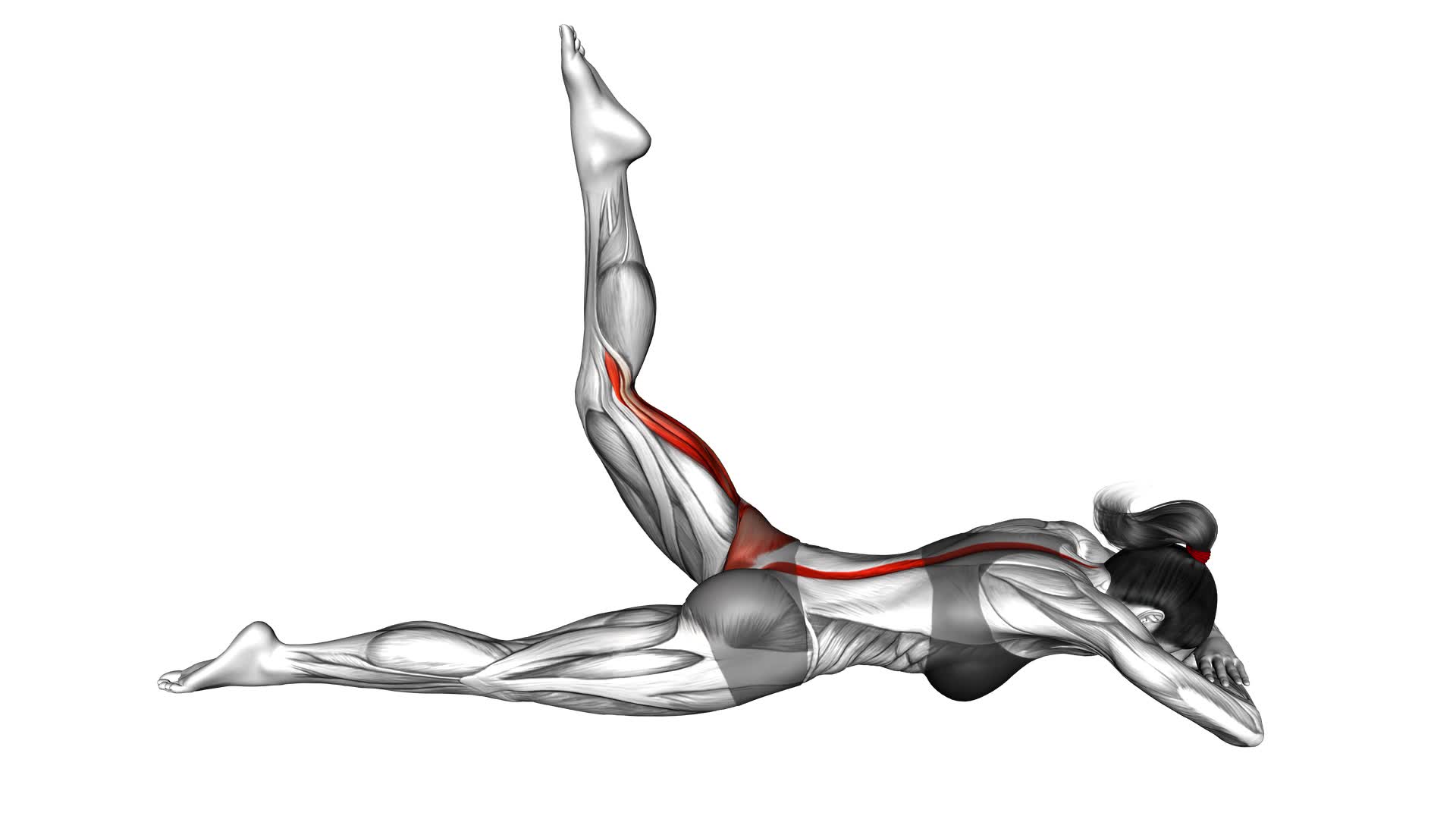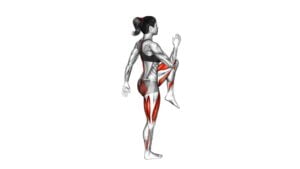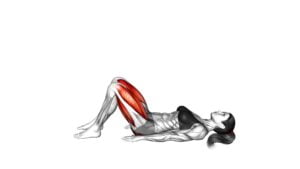Lying Single Glute Lift (female) – Video Exercise Guide & Tips

Incorporate the lying single glute lift into your fitness routine for a targeted lower body workout. This video exercise guide will show you the proper form and technique to maximize the benefits of this exercise. You'll discover the equipment needed and learn modifications for different fitness levels.
Watch This Exercise Video
Avoid common mistakes and achieve better results with helpful tips. Get ready to strengthen and sculpt your glutes with the lying single glute lift. Let's get started!
Key Takeaways
- The lying single glute lift is highly effective for glute activation and muscle toning.
- It targets the gluteus maximus, the largest muscle in the buttocks, to enhance strength and definition.
- This exercise improves overall lower body strength and stability.
- The lying single glute lift can be incorporated into various workout routines for a targeted lower body workout.
Benefits of the Lying Single Glute Lift
You can achieve stronger glutes by incorporating the lying single glute lift into your workout routine. This exercise is highly effective for glute activation and muscle toning. The lying single glute lift specifically targets the gluteus maximus, which is the largest muscle in your buttocks. By engaging this muscle, you can enhance its strength and definition.
To perform the lying single glute lift, start by lying on your back with your knees bent and feet flat on the floor. Place your arms by your sides for stability. Then, lift one leg off the ground while keeping the knee bent at a 90-degree angle. Push through your heel and squeeze your glutes to lift your hips off the floor. Hold for a moment at the top and then slowly lower your hips back down. Repeat this movement for the desired number of repetitions, then switch to the other leg.
Incorporating the lying single glute lift into your workout routine can help you achieve a more sculpted and toned booty. It's a simple yet effective exercise that requires no equipment, making it a convenient choice for home workouts.
Equipment Needed for the Exercise
To effectively perform the Lying Single Glute Lift exercise, there are a few essential pieces of equipment you'll need.
Firstly, a yoga mat or exercise mat will provide comfort and support during the exercise.
Additionally, a resistance band or ankle weights can be used to add resistance and challenge to the movement.
Lastly, it's important to ensure that the equipment is in good condition and properly set up to prevent any potential injuries during the exercise.
Essential Exercise Equipment
To perform the lying single glute lift exercise, you'll need a resistance band. This essential exercise equipment adds resistance to your glute workout, helping to strengthen and tone your glute muscles more effectively.
Resistance bands come in different options, such as different levels of resistance, lengths, and widths. You can choose the band that suits your fitness level and goals.
Additionally, resistance bands offer variations and modifications to the exercise. For instance, by placing the resistance band above your knees instead of ankles, you can increase the intensity of the exercise. You can also try using a loop band or mini band for a different challenge.
These equipment options and variations allow you to customize your workout and target your glutes efficiently.
Alternatives to Equipment
If you don't have access to resistance bands, there are alternative options for the lying single glute lift exercise. You can perform this exercise without any equipment, using just your bodyweight.
One alternative is the bodyweight glute bridge. To do this exercise, lie on your back with your knees bent and feet flat on the ground. Lift your hips off the ground, squeezing your glutes at the top.
Another option is the bodyweight hip thrust. Sit on the ground with your back against a sturdy object like a bench or step. Bend your knees and place your feet flat on the ground. Lift your hips up, driving through your heels, and squeeze your glutes at the top.
These bodyweight exercises can effectively target and strengthen your glutes.
Now, let's move on to the next section and discuss safety precautions for equipment.
Safety Precautions for Equipment
Ensure you have the necessary equipment for the lying single glute lift exercise to safely and effectively target your glutes. Safety precautions should always be taken when using equipment to minimize the risk of injury. Before beginning the exercise, make sure that the equipment is in good condition and properly maintained. Check for any loose parts or broken components that could pose a safety hazard. Additionally, ensure that the equipment is set up correctly and securely before starting the exercise.
Proper technique is crucial for both safety and effectiveness. Pay attention to your form and maintain proper body alignment throughout the exercise. This will help to prevent strain or injury to your muscles or joints.
Now, let's move on to the next section to learn about the proper form and technique for the lying single glute lift.
Proper Form and Technique for the Lying Single Glute Lift
To perform the lying single glute lift with proper form and technique, start by lying on your back with your knees bent and feet flat on the floor. Place your arms by your sides, palms facing down. Engage your core muscles by drawing your navel towards your spine. Keep your pelvis in a neutral position throughout the exercise.
Begin the movement by lifting one foot off the floor, keeping your knee bent at a 90-degree angle. Press through your heel and squeeze your glute muscles as you lift your hips off the ground. Your body should form a straight line from your shoulders to your knees. Hold this position for a brief moment, then lower your hips back down to the starting position.
To ensure proper form during the lying single glute lift, avoid these common mistakes:
1) Avoid arching your lower back excessively; maintain a neutral spine.
2) Don't let your knees cave inward or splay outwards; keep them aligned with your hips.
3) Avoid using momentum or bouncing to lift your hips; focus on controlled movements.
Modifications and Progressions for Different Fitness Levels
For different fitness levels, you can modify and progress the lying single glute lift. Whether you're a beginner or an advanced practitioner, there are various modifications and variations that can be implemented to suit your needs and goals.
Here are some options to consider:
- Modifications for injuries: If you have any existing injuries, it's crucial to modify the exercise to prevent further strain or discomfort. For example, you can reduce the range of motion or use a resistance band for added support.
- Variations for advanced practitioners: If you're looking to challenge yourself and take the exercise to the next level, there are several variations you can try. These include using ankle weights, incorporating a stability ball, or performing the exercise on an inclined surface to increase the intensity.
- Progressive overload: To continually progress and improve, gradually increase the number of repetitions, sets, or resistance used during the exercise. This will help to build strength and endurance over time.
- Balance challenges: By performing the exercise on an unstable surface such as a balance board or foam pad, you can enhance your balance and stability while targeting the glute muscles.
- Combining with other exercises: To create a more comprehensive workout, you can incorporate the lying single glute lift with other glute-focused exercises such as lunges, squats, or hip thrusts. This will provide a well-rounded workout for your glute muscles.
Remember to listen to your body and choose modifications or progressions that are appropriate for your current fitness level and goals.
Common Mistakes to Avoid During the Exercise
As you progress through your lying single glute lift exercise, it's important to be aware of common mistakes to avoid in order to maximize the effectiveness of the movement.
Maintaining proper form is crucial to target the glute muscles and prevent injury.
One common mistake is lifting the leg too high, which can shift the focus away from the glutes and onto the hip flexors. To ensure proper form, lift the leg only until it's parallel to the ground.
Another mistake to avoid is arching the lower back during the lift. This can lead to excessive strain on the lower back and diminish the effectiveness of the exercise. Instead, engage your core and focus on lifting the leg using the glute muscles.
Lastly, avoid rushing through the exercise and using momentum to lift the leg. This reduces the intensity and impact on the glutes. Instead, perform the movement slowly and with control, emphasizing the contraction of the glute muscles.
Tips for Incorporating the Lying Single Glute Lift Into Your Fitness Routine
To effectively incorporate the lying single glute lift into your fitness routine, start by adjusting your positioning on the exercise mat. This exercise targets your glute muscles, helping to strengthen and tone them.
Here are some tips to help you get the most out of this exercise:
- Start by lying on your back with your knees bent and feet flat on the ground.
- Place your arms by your sides, palms facing down.
- Engage your core and squeeze your glutes as you lift one leg off the ground, extending it straight up towards the ceiling.
- Hold for a second and then slowly lower your leg back down.
- Repeat on the other leg.
Incorporating variations of the lying single glute lift can add variety to your routine and challenge your muscles in different ways. You can try performing the exercise with ankle weights or using a resistance band around your thighs to increase the intensity. Additionally, you can incorporate this exercise into your routine at any time, but it may be best to perform it after a lower body workout to fully fatigue your glute muscles.
Remember to listen to your body and adjust the exercise as needed to ensure proper form and avoid any discomfort or pain.
Frequently Asked Questions
How Many Reps and Sets Should I Do for the Lying Single Glute Lift?
For optimal glute activation, aim for 3-4 sets of 8-12 reps for the lying single glute lift. This range allows for sufficient muscle stimulation without overloading the muscles.
To ensure proper form, lie on your side with your bottom leg bent and your top leg straight. Lift your top leg as high as comfortably possible while keeping your core engaged and hips stacked.
Avoid common mistakes like lifting your leg too high or using momentum to lift.
Can the Lying Single Glute Lift Help With Improving Posture?
Improving posture can be achieved through the lying single glute lift.
This exercise specifically targets the gluteus muscles, which play a crucial role in maintaining proper posture. By strengthening these muscles, you can support the alignment of your spine and improve overall posture.
The lying single glute lift offers several benefits, including increased hip stability, reduced lower back pain, and improved balance. Incorporating this exercise into your routine can contribute to better posture and overall body alignment.
Is It Normal to Feel Discomfort or Tightness in the Hip During the Exercise?
Feeling discomfort or tightness in your hip during the exercise isn't uncommon. It may be due to muscle imbalances or tightness in the hip flexors. Proper form and alignment are crucial to prevent this.
Engaging your glutes and core muscles while performing the exercise can help alleviate the discomfort.
If the discomfort persists or worsens, it's advisable to consult a fitness professional or healthcare provider for further evaluation and guidance.
Can the Lying Single Glute Lift Be Performed With Ankle Weights for Added Resistance?
Yes, you can perform the lying single glute lift with ankle weights to add resistance. Using ankle weights can increase the challenge and intensity of the exercise, helping to further strengthen and tone your glute muscles.
It's important to start with lighter weights and gradually increase as you feel comfortable and confident.
Additionally, there are variations of the lying single glute lift that can target different areas of the glutes for a well-rounded workout.
Are There Any Alternative Exercises That Target the Same Muscle Group as the Lying Single Glute Lift?
If you're looking for alternative exercises that target the same muscle group as the lying single glute lift, there are a few options you can try.
One option is the hip thrust, which also focuses on the glute muscles.
Another alternative is the glute bridge, which engages the same muscle group.
These exercises can provide a similar workout and help strengthen your glutes.
Remember to maintain proper form and consult a fitness professional for personalized guidance.
Conclusion
In conclusion, the lying single glute lift is a beneficial exercise for targeting and strengthening the glute muscles.
With the proper equipment and technique, this exercise can be modified to suit different fitness levels and help avoid common mistakes.
By incorporating the lying single glute lift into your fitness routine, you can improve your overall lower body strength and enhance your athletic performance.
Remember to always prioritize proper form and consult with a fitness professional if needed.

Author
Years ago, the spark of my life’s passion ignited in my mind the moment I stepped into the local gym for the first time. The inaugural bead of perspiration, the initial endeavor, the very first surge of endorphins, and a sense of pride that washed over me post-workout marked the beginning of my deep-seated interest in strength sports, fitness, and sports nutrition. This very curiosity blossomed rapidly into a profound fascination, propelling me to earn a Master’s degree in Physical Education from the Academy of Physical Education in Krakow, followed by a Sports Manager diploma from the Jagiellonian University. My journey of growth led me to gain more specialized qualifications, such as being a certified personal trainer with a focus on sports dietetics, a lifeguard, and an instructor for wellness and corrective gymnastics. Theoretical knowledge paired seamlessly with practical experience, reinforcing my belief that the transformation of individuals under my guidance was also a reflection of my personal growth. This belief holds true even today. Each day, I strive to push the boundaries and explore new realms. These realms gently elevate me to greater heights. The unique combination of passion for my field and the continuous quest for growth fuels my drive to break new ground.







